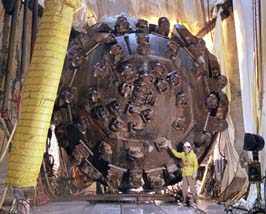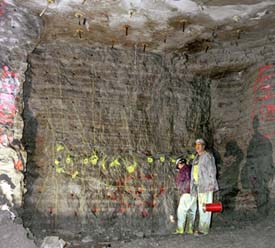 |
|
Diggin In by Kurt Riesselmann
It’s dark, it’s wet and—most of all—it’s huge.
Miners of the S.A. Healy company are carrying out the final excavation work
for a new underground facility at Fermilab that could easily store thousands
of cars, neatly lined up and stacked on top of each other. Since April 2000,
construction crews have worked in three shifts, six days a week, to create
an intricate system of tunnels and halls.
But this new space isn’t tagged as a parking garage. Physicists will use
the new caverns to build a research laboratory called Neutrinos at the Main
Injector (NuMI). Two large underground halls and 4,000 feet of tunnels will
host scientific equipment to create and analyze neutrinos, the most evasive
particles of the universe.
Scientists will crash protons from Fermilab’s Main Injector accelerator into
a graphite target in the first NuMI underground hall, at a depth of 150 feet.
The resulting neutrinos will then traverse a second underground hall, 350 feet
deep, where a particle detector will record the neutrinos’ properties. From
there the neutrinos will continue their journey through 450 miles of rock
to hit a second detector in a former iron mine in Soudan, Minnesota. While
traveling through the rock—no tunnel is needed—the neutrinos may “change
flavors,” transforming from one type into another. Because of its relevance to
the evolution of the universe, this process is of great interest to physicists.
But unlike conventional transportation tunnels, NuMI’s will never have traffic
jams.
“The NuMI underground construction is different from—and probably a bit
more difficult than—a transportation-tunnel project,” said John Sollo, NuMI
construction coordinator. “Access to the NuMI main tunnels is only through
vertical shafts rather than a drive-in portal from either end.”
In the absence of elevators (to be installed this fall), workers enter the
construction site via a metal cage that is lifted and lowered into the tunnels
by a crane. Every piece of equipment, from shovels to front-end loaders,
has come through the access shafts. And every piece of rock has gone out
through one of the shafts. Millions of pieces. Or more precisely: one hundred
thousand cubic yards of rock, more than 2,000 truckloads.
Excavating tunnels is nothing for the faint at heart. The environment
underground is cold and wet. Temperatures of 55 degrees Fahrenheit are the
norm, and fog is not unusual. During the construction, a couple of hundred
gallons of water have entered the NuMI tunnels—per minute! Even after the
facility is complete, engineers expect a continued inflow of approximately
150 gallons per minute, which will be removed by powerful sump pumps.
Taking no risk
“The only way to improve safety culture is through
communication,” said Mike Andrews, who joined
the NuMI project after the accident to become the
coordinator for environment, safety and health. “We
really beefed up the daily hazard analysis program.
We have safety meetings, toolbox meetings and
daily planning meetings to help the crew members
understand what the issues are. The foremen are
now very clear on what they mean and how they
present it. And the miners know that we don’t just
talk about safety, but that we really mean it.”
“Safety constantly needs attention,” said
construction manager Dixon Bogert. “It’s fair to
say that safety has improved, but it’s not an area
in which we can relax.”
Having a blast
“The various NuMI tunnels and halls have different
dimensions and cross sections,” said project
engineer Chris Laughton. “Healy chose the
excavation methods that they considered the
best for the different parts of the project. Using
a variety of excavation techniques is not a
technical challenge but a logistical one.”
Miners used the tunnel boring machine to excavate
the 21-foot-diameter tunnel between the two
underground halls. At its best, the TBM advanced
by more than 70 feet a day, but more typically
mined at less than half that rate. To excavate the
access shafts and underground halls, miners
carried out more than 400 blasts, removing
up to ten feet of rock in one blast.
To limit the impact of blasts on both Fermilab’s
scientific facilities and the surrounding
neighborhood, miners had to follow strict
specifications.
“The noise and vibration restrictions [specified in
the contract with S.A. Healy] were a main issue
during drill and blasting,” explained Sollo. “Those
restrictions are common in urban areas, but
unusual for most underground work.”
Fermilab closely monitored the noise and vibration
created by each blast. Although the blasts never
exceeded vibration levels, some blasts were much
louder than expected. Unfavorable northeast winds
and dense cloud coverage sometimes intensified
and projected the noise into the adjacent
neighborhood, startling neighbors by rattling
windows.
“We’ve greatly appreciated the patience and
cooperation of our neighbors,” said NuMI project
manager Greg Bock. “Their observations and
feedback were as valuable to us as the data we
obtained from scientific monitoring equipment.”
The NuMI excavation, with only a few blasts still
to come, has lasted twenty-six months, so far
some six months longer than originally anticipated.
According to a revised schedule, accepted by
a Department of Energy review committee in
September 2001 (see FERMINEWS, Sept. 28,
2001, vol. 24, no. 16), the NuMI facility will be
operational in 2005.
“This work has taken much longer than we
expected,” Bock said. “But since March, when
Healy significantly increased their work force,
progress has been good and we’re looking forward
to starting the follow-on contract toward the end
of the year.”
Precise aim
The manufacturer of the steel pipe will deliver
fifty-six sections, each forty feet long and seven
feet in diameter. Welders have already put together
more than a third of the total decay pipe inside the
NuMI tunnel.
“There is a bunch of things involved to make sure
that the beam goes to the right point in Minnesota,”
said Wesley Smart, the physicist in charge of
NuMI’s alignment. “The contractor is responsible
for putting things in the right place, and Fermilab
surveyors do the quality assurance.”
Physicists expect the center of the neutrino beam
to hit the far detector in Soudan to within forty feet.
To achieve this goal, the alignment of the tunnels
at Fermilab must be exact within a few inches. The
most critical part will be the installation of all beamline
components. Since neutrinos have no electric
charge, it is impossible to manipulate the direction
of the neutrino beam after it has been created.
So far, Smart is pleased with what he has seen.
“Healy’s picked a good surveyor,” he said. “The first
part of the decay pipe is within three quarters of an
inch of the ideal location. That’s what the contract
allows.”
New buildings to come
“When Healy is done with its contract,” said
Plunkett, “the next step is to change the empty hole
in the ground to an underground laboratory, from
a hostile environment into a friendly one.”
A few weeks ago, Plunkett and his colleagues
sent out requests for bidding proposals for the new
contract, which includes the construction of service
buildings on top of two access shafts. The work
is expected to take one year and cost more than
ten million dollars. It includes a service building
that will stand near Fermilab’s main entrance
(see graphic below).
“It will be an industrial-type building with a big hole
—350 feet deep—in the floor,” said Rob Plunkett.
“The building is mostly used for staging. Eventually,
the MINOS detector, one plane at a time, will come
through this space.”
The Main Injector Neutrino Oscillation Search
detector at Fermilab will consist of 280 planes
of steel and scintillator. Technicians are currently
assembling the planes at Fermilab. It is a smaller
version of the detector at Soudan, which is already
under construction and almost half complete.
“So much work has to come together,” said
Plunkett. “It has to grow like an organism.”
Three years from now, NuMI will be all grown up
and ready to run.
“The next step is to change
the empty hole in the ground to an underground laboratory.”
|
 The only tunnels required for the NuMI project are a tunnel connecting the
existing Main Injector accelerator to the new target hall, and a half-mile-long
tunnel connecting the target hall to the near detector hall. Miners completed
these tunnels in December.
The only tunnels required for the NuMI project are a tunnel connecting the
existing Main Injector accelerator to the new target hall, and a half-mile-long
tunnel connecting the target hall to the near detector hall. Miners completed
these tunnels in December.
 The new approach has had the desired effect.
Since the accident the number of safety incidents
per worked man-hour has dropped by almost
50 percent compared to the first sixteen months
of the project. For Fermilab’s project managers,
however, this is not yet enough.
The new approach has had the desired effect.
Since the accident the number of safety incidents
per worked man-hour has dropped by almost
50 percent compared to the first sixteen months
of the project. For Fermilab’s project managers,
however, this is not yet enough. In April, S.A. Healy began the installation of a
2,000-foot-long decay pipe. The work is part of
Healy’s 30.5-million-dollar contract with the
Department of Energy. It presents the first
important step in outfitting the tunnels with
infrastructure and scientific equipment.
In April, S.A. Healy began the installation of a
2,000-foot-long decay pipe. The work is part of
Healy’s 30.5-million-dollar contract with the
Department of Energy. It presents the first
important step in outfitting the tunnels with
infrastructure and scientific equipment.
